How failed operation "Edelweiss"
The command of the German Army Group "A" was preparing to continue the offensive. The enemy decided to develop the offensive simultaneously in three directions:
1) 1st tank the army was to strike in a southeastern direction, take control of the Grozny area, go to the coast of the Caspian Sea and capture Baku;
2) the 17 Army was tasked to launch an offensive on Novorossiysk and further along the Black Sea coast on Batumi. The 42 Army Corps of the 11 Army was to force the Kerch Strait and, providing the right flank of the 17 Army, to occupy the Taman Peninsula;
3) The 49 th Mountain Rifle Corps was intended for striking through the passes of the Main Caucasus Range with access to the region of Sukhumi and Kutaisi. In accordance with the offensive plan in the Army Group "A", the troops were regrouped.
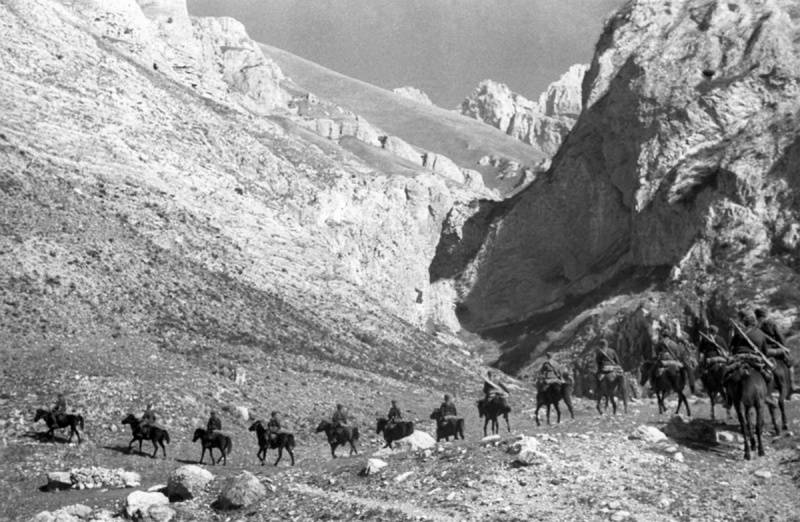
Soviet Horse Intelligence in the Caucasus Mountains
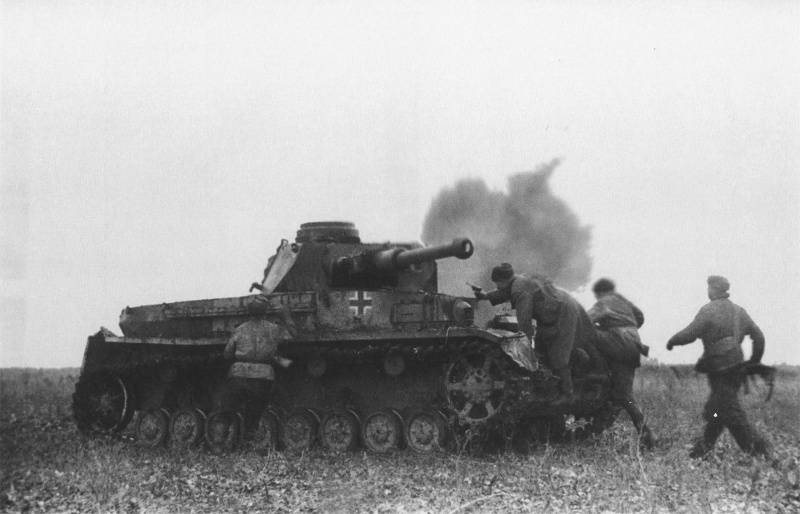
The Red Army soldiers captured a German tank Pz.Kpfw on the battlefield near Mozdok. IV
In the second half of August, completing the regrouping, the German troops resumed the offensive. The second stage of the defensive battle for the Caucasus began, which lasted from 18 August to 28 September 1942 g. During this time, the enemy, striking from three directions, tried to break through to the Transcaucasus. The 1-th tank army as part of the 3-th and 40-th tank corps and the 52-th army corps launched an offensive from the region of Stavropol and Nevinnomyssk in the general direction of Pyatigorsk, Prokhladny, Grozny. By the end of August, this Wehrmacht grouping reached the Terek and Baksan rivers in the area from Ishcherskaya to Baksansky gorge (30 km west of Prokhladny), where it was stopped by the main forces of the Northern group of troops of the Transcaucasian Front. Furious battles broke out at this turn. The enemy failed to make a breakthrough on Ordzhonikidze from the region to the west and south of Prokhladny. The Germans were forced to abandon further attempts to develop an offensive here. After that, the main forces of the 1 tank army were concentrated in the area of Mozdok to attack the Mozdok-Malgobey direction.
On September 1, the mobile units of the enemy launched an offensive on the Malgobek direction, seeking to break through the defenses of the Soviet troops on the r. Terek and capture the city of Malgobek with its oil fields. In the future, the enemy troops were, developing success, to strike at Grozny, Makhachkala, Derbent and Baku. To achieve these goals, the German command planned to reinforce the 1 Tank Army at the expense of the formations that it intended to transfer to the Caucasus from the Stalingrad sector after the alleged capture of Stalingrad.
Terek, which in itself was a serious obstacle, was strengthened by the Northern Group troops taking positions at its turn. The Germans were opposed by units of the 9 Army, as well as units of the 11 Guards Rifle Corps deployed to the combat area. The Germans forced the river. Terek in the area south of Mozdok, and only after heavy fighting by the forces of the 23 Panzer Division, captured a bridgehead on the right bank. The commander of the 9 Army, Major-General V. N. Martsenkevich, responded to this, replaced by Major-General K. A. Koroteev.
Our troops organized a series of counterattacks, trying to push the enemy back, but without success. On September 14, the Germans captured another bridgehead, this time with the help of the Brandenburg special regiment. They captured the 1200-meter bridge on the Rostov-Grozny-Baku railway. The bridge was mined with 4,5 tons of explosives, but the saboteurs managed to prevent it from exploding. Concentrating considerable forces on the bridgehead, the Wehrmacht launched an offensive against Malgobek. Only after a stubborn struggle, the Germans managed to capture Malgobek, but they could not move further in this direction.
In the second half of September, the German army launched an offensive on the Grozny direction south-west of Mozdok, but was not able to succeed here either. The German command was forced to transfer to the reinforcement of the 1 tank army in the area of Mozdok the SS Viking division, removing it from the Tuapse direction. After that, the Nazis again launched an offensive, trying to break through to Ordzhonikidze and Grozny through the Elkhotov Gate, but could not break the resistance of our troops. As a result, the Malgobek operation, which lasted 28 days, the enemy's 1 tank army was forced to abandon the offensive in the direction of Grozny and went on to the defensive. The enemy could not strengthen his troops in the Grozny direction by transferring divisions from Stalingrad, since the German plans on the Volga were thwarted by the fierce resistance of the Soviet troops.
"Caucasian Stalingrad"
At the same time, the troops of the North Caucasus Front fought heavy defensive battles in the Novorossiysk direction and the Taman Peninsula. The 17th German army, consisting of the 57th Panzer Corps, the 5th and 44th Army Corps, and the 4th Romanian Cavalry Corps, launched an offensive from the Krasnodar region to Novorossiysk in the second half of August. After the capture of Novorossiysk, the Germans planned to strike along the Black Sea coast on Tuapse and then on Batumi. To support the 17th Army, the German command began to transfer from the Crimea to the Taman Peninsula the 42nd Army Corps of the 11th Army. The stubborn defense of the Temryuk and Kerch naval bases (the first on August 24, the second on September 5) thwarted the planned time for the German command to force the Kerch Strait, and ensured a breakthrough of the ships of the Azov military flotilla from the Sea of Azov to the Black. However, it was not possible to prevent the landing of enemy troops and the capture by the 42nd German corps of the Taman Peninsula.
The fierce battles were fought in the Novorossiysk direction, where the defense was held by the troops of the 47 Army with the support of units of the marines. In all, by August 18 the number of Novorossiysk defenders was about 15 thousand people. Air support was provided by 112 aircraft. 20 and 21 August fierce fighting went on in the area of the villages of Abinskaya and Crimea. By the end of August 21, the Germans took Abinsk and Crimea, creating the threat of a breakthrough through the passes to Novorossiysk. Two days later, the Nazis had the opportunity to fire at the port and the city of Novorossiysk. However, the enemy failed to break through to Novorossiysk on the move. The stubborn defense of the 47 Army forced the 17 Army of August 25 to suspend the offensive. The command of the 17 of the German army removed some of the forces from the Tuapse direction in order to strengthen its troops in the Novorossiysk sector.
By September 1, the enemy broke through to the Black Sea coast near Anapa. The infantry units operating on the Tamansky Peninsula, cut off from the main forces of the front, were evacuated by sea to Gelendzhik by order of the command of September 5 and poured into the Black Sea group of troops. On the same day, the enemy was busy Anapa.
Bloody battles in early September continued for Novorossiysk. Taking advantage of low activity aviation enemy, Black Sea Fleet ships participated in the defense. On September 5, the shelling of German formations advancing on the city was carried out by the leader of Kharkov and the destroyer Soobrazitelny. However, on September 7, the German 9th Infantry Division nevertheless made its way to Novorossiysk. After three days of fierce street fighting, on the night of September 10, Soviet troops were evacuated to the eastern shore of Tsemess Bay. For the breakthrough of the enemy to Novorossiysk, G.P. Kotov was removed from the post of commander of the 47th army, and A.A. Grechko took his place.
Thus, after a stubborn struggle, the Wehrmacht managed to seize most of the city of Novorossiysk and the Taman Peninsula. But the enemy failed to develop an offensive along the Black Sea coast on Tuapse. The troops of the Black Sea Group of the Transcaucasian Front in fierce battles stopped the enemy at the turn of Mount Dolgaya - Adamovich gully - cement factories. The command of Army Group "A" made a regrouping of forces and again threw them into the offensive, striking from the Abinsk area on Gelendzhik in order to cut off and then destroy the Soviet troops that were under the Novorossiysk. In the fierce battles that continued until the end of September, the enemy failed to accomplish the task. In the area of Novorossiysk, the enemy could not use the only seaside road on Tuapse that was passed here, which our troops had tightly closed. Over the next months of fighting, the Germans did not manage to pass through the Novorossiysk gates and unite with the Wehrmacht grouping advancing on Tuapse from the north.
The battle for Novorossiysk, which went on and on, became one of the most fierce and heroic villages of the Great War. Novorossiysk became a kind of "Caucasian Stalingrad". STZ and Barrikady were in Stalingrad, the Proletary cement plant was in Novorossiysk. The Soviet troops, retaining the eastern shore of the Tsemesskaya bay, did not allow the enemy to use Novorossiysk as a port and naval base.
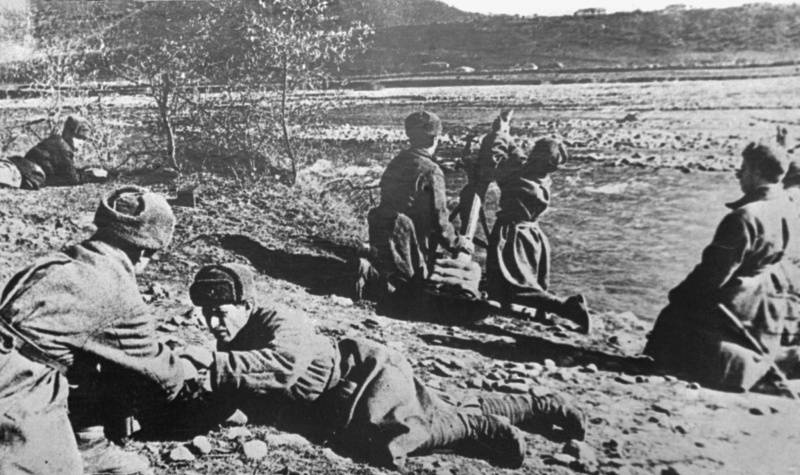
The calculation of the 82-mm battalion mortar model 1937 g. (BM-37) are firing on enemy fortifications in the area of the city of Ordzhonikidze, during the defensive Nalchik-Ordzhonikidze operation
Fighting at the passes of the Main Caucasus Range
Along with the attacks on the Grozny and Novorossiysk directions, the enemy made an attempt to break through to the Black Sea coast through the passes of the central part of the Main Caucasian Range. This task was to be solved by the 49 th Mountain Rifle Corps, specially prepared for action in high mountain conditions. The Germans began to advance from the Nevinnomyssk and Cherkessk areas across the passes of the Greater Caucasus Mountains in the direction of Kutaisi and Sukhumi. In the future, these troops were to assist the 17 Army in advancing along the Black Sea coast to Batumi.
Initially, the offensive of the enemy troops was successful. The command of the 46 Army of the Transcaucasian Front, which in July received an order to organize the defense of the passes, did not take the necessary measures for this in a timely manner. In the first days after the beginning of the offensive, parts of the 49 of the German Mountain Corps occupied the settlements of Upper Teberda, Zelenchukskaya, Storozhevaya, Akhmetovskaya. Using specially trained groups of climbers, the enemy began to occupy the passes in the area from Mount Elbrus to Umpyrsky Pass. In the 20-s of August, the Hitlerites captured the passes of Klukhor, Marukh, Sancharo and a number of others. The detachments of the 3 Infantry Corps of the 46 Army were pushed back to the southern slopes of the passes. Thus, the enemy managed to reach the southern slopes of the Greater Caucasus Mountain Range, creating the threat of seizing Sukhumi and a breakthrough to the Black Sea coast.
The headquarters of the Supreme Command ordered the commander of the Transcaucasian Front to take urgent measures to eliminate the enemy’s breakthrough through the Main Caucasus Range. To repel the enemy offensive, additional forces were deployed, air supplies were organized for subunits and detachments leading battles in the mountains, passes and mountain trails exploded and collapsed in areas where there were no defenses. Special attention was paid to the organization of the defense of the Military-Georgian, Military-Ossetian and Military-Sukhumsk roads. 1 September The headquarters made an important organizational decision - to unite the North Caucasus and Transcaucasian fronts. The united front was called Transcaucasian. The North Caucasian Front Directorate formed the basis of the Black Sea Group of the Transcaucasian Front, which significantly increased the stability of the defense on the coastal sector of the front. I.Tyulevev began to command the front, the Black Sea group of troops was headed by Ya.T. Cherevichenko, and S.M. Budyonny was summoned to Moscow at the disposal of the Headquarters. In general, it can be said that under the leadership of Budyonny, the front forces managed to avoid the encirclement planned by the Germans south of the Don. However, the breakthrough of the German mountain rangers through the passes was not forgiven for him.
As a result, after a month of fierce battles, the offensive of the enemy through the passes of the central part of the Main Caucasian Range was stopped. On the Klukhor and Sankhor directions, where the German troops managed to reach the southern slopes of the passes, the enemy was thrown back to the northern slopes of the ridge.
Thus, by the end of September, after a month and a half of fierce fighting by the forces of the North Caucasus and Transcaucasian Fronts, the path of the German army in Transcaucasia was blocked in all three directions of its offensive - on the approaches to Ordzhonikidze, at the central passes of the Main Caucasus Range, on the Black Sea coast Novorossiysk. This ended the second stage of the defensive battle in the battle for the Caucasus.
The commander of Army Group "A" reported to the Führer that the available forces could not carry out the tasks assigned. Hitler sent Colonel-General Jodl to the front with the task of examining the situation on the spot and determining the possibilities for the Army Group A to continue its offensive. Yodl agreed with the opinion of Field Marshal Liszt. Hitler, who already had distrust of some of his generals, removed Field Marshal List from the post of commander of an army group, and Colonel General von Kleist was appointed in his place. But this measure could not change the situation in favor of the Wehrmacht.
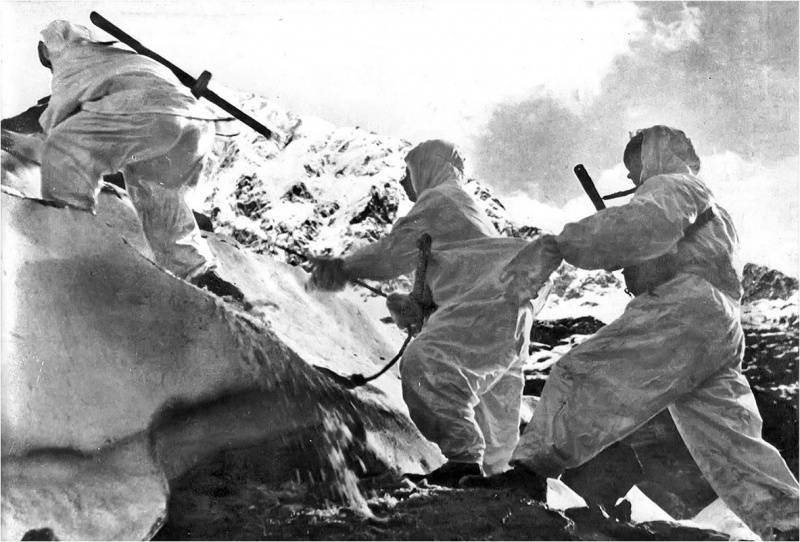
Climbing warriors under the command of Lieutenant A.S. Efremova climb the glacier to defend the mountain pass. North Caucasus, 1942
Completion of the defensive stage
28 September 1942 began the final stage of the defensive battle of the Battle of the Caucasus. Despite the heavy losses, lack of manpower and resources, the length of communications, the German command tried to seize the Caucasus at any cost. The Germans decided to strike again on the Tuapse direction in order to break through into the Transcaucasus through the western part of the Main Caucasus Range. To accomplish this task, the enemy commanders formed a strong grouping on the left flank of the 17 Army consisting of up to 14 divisions. The Germans planned to strike and destroy the 18 Soviet army from Khadyzhensk and Goryachiy Klyuch districts in Shahumyan, then go to Tuapse and then, after defeating the troops of the Black Sea group, develop an offensive along the coast on Sukhumi and Batumi.
However, the overall balance of forces in the Caucasus by this time has really changed significantly. The enemy has already spent its reserves during offensive operations in the North Caucasus, and was not able to get strong reinforcements, while the troops of the Transcaucasian Front for the same period significantly increased, created reserves and began preparations for the transition to the offensive. The Tuapse sector was covered by the Black Sea group of troops of the Transcaucasian Front.
On September 25, German troops launched an offensive, and furious battles flared up again in the Tuapse sector. During the first two days, the enemy was unable to succeed, but later he managed to break into separate sections of the Soviet army 18-5 km at some sites. By October 10 the Germans reached the railroad and highway in the area south of the station. Khadyzhenskaya. The situation on the Tuapse direction was becoming more and more dangerous. The October 3 rate 15 pointed out to the Transcaucasian Front commander that he had underestimated the role of the Black Sea Group and the seriousness of the situation that had arisen on the Black Sea route. With the release of enemy troops to Tuapse, the troops of the Black Sea Group would be cut off from the rest of the forces of the Transcaucasian Front, which created the threat of their death. The headquarters demanded more attention from the commander of the Transcaucasian Front to the Tuapse direction.
On October 19, the Germans launched an assault on the Elizavetpolsky Pass and captured it, but the further advance of the enemy was stopped. In other sectors, the attacks of the German troops were repulsed. In late October, the Wehrmacht was forced to temporarily suspend the attack on the Tuapse direction. Only in the second half of November, he resumed the offensive again and broke through in the direction of Tuapse on 30 km. However, this was the end of the successes of the German army. Part of the 18 Army repulsed all subsequent attacks of the enemy, and then went on the offensive. To seize Tuapse the Nazis did not succeed. Fierce fighting in the western part of the Main Caucasus Range continued until mid-December 1942. As a result, the forces of the Transcaucasian Front not only repelled all German attacks, but also broke up the enemy grouping that was trying to break through to Tuapse.
At the same time, the brutal marched on the right wing of the Transcaucasian Front, where the enemy continued his attempts to develop an offensive on the Grozny direction. The balance of forces here at this time was in favor of the Northern Group of the Transcaucasian Front, which was preparing for active offensive actions on the Malgo-Bozd-Mozdok direction. However, on the Nalchik-Ordzhonikidze sector, the defense was occupied by the 37 Army weakened in previous battles. The Germans prepared a blow in that direction. On October 25, the German 1-I tank army launched an offensive on the Nalchik-Ordzhonikidze sector, in order to then break through to Grozny, Baku and along the Georgian Military Highway to Tbilisi.
October 26 German troops captured Nalchik and began to develop an offensive against Ordzhonikidze. In difficult conditions of the military situation, the troops of the 37 Army were forced to retreat to the foothills of the Main Caucasian Range, while exhausting the enemy in stubborn battles and increasing resistance. The 9 Army of 5, which soon arrived from the Northern Group of Forces, finally stopped the Nazi offensive in the Gizel area on the approaches to Ordzhonikidze. The next day, the troops launched a strong counter-attack, and the Germans began to retreat to Alagir. In pursuit of the retreating German troops, Soviet units and units in battles before 12 November defeated the 13 German Tank Division, the Brandenburg regiment, inflicted serious losses on the 23 German Tank Division, 2 of the Romanian Mountain Rifle Division and other enemy troops. During the defeat of this tank group, Soviet troops seized 140 tanks (faulty), 7 armored vehicles, 70 guns, 95 mortars, 183 motorcycles, 2350 vehicles (most of the faulty) and many different military equipment.
The defeat of the 1 Tank Army in the Gizel area forced the enemy to abandon further attempts to break through to the Grozny and Baku oil districts. In addition, the defeat of von Mackensen’s troops and the 9 Army units’s subsequent counterattacks in the second half of November prevented the transfer of the 3 Tank Corps to the Stalingrad sector. In December, the German command was able to send only two divisions from the North Caucasus to Stalingrad — one tank and one motorized — and in exchange for them to transfer from the Crimea one infantry and one airfield division.
Thus, in October-December, the German command again attempted to conduct an offensive on the Tuapse and Grozny axes. But having met the stubborn resistance of the Soviet troops, the enemy could not achieve noticeable success. In the autumn months of 1942, the army of the Transcaucasian Front, receiving replenishment, significantly intensified their actions, inflicting a series of counterattacks, forcing the enemy to constantly change their intentions, more and more often to go on the defensive. Gradually, the situation stabilized, and then the initiative began to move to the side of our troops. The Wehrmacht has exhausted all possibilities for offensive operations in the Caucasus.
As the modern military historian A. Isaev notes: “In general, the battle for the Caucasus developed according to the scenario that was typical for successful Soviet defensive operations: defense with the accumulation of forces to go on the offensive. A feature of the fighting in the Caucasus was the impossibility of the exchange of time on the territory. The Soviet troops managed to retreat a considerable distance only in the short initial phase of the operation. ”
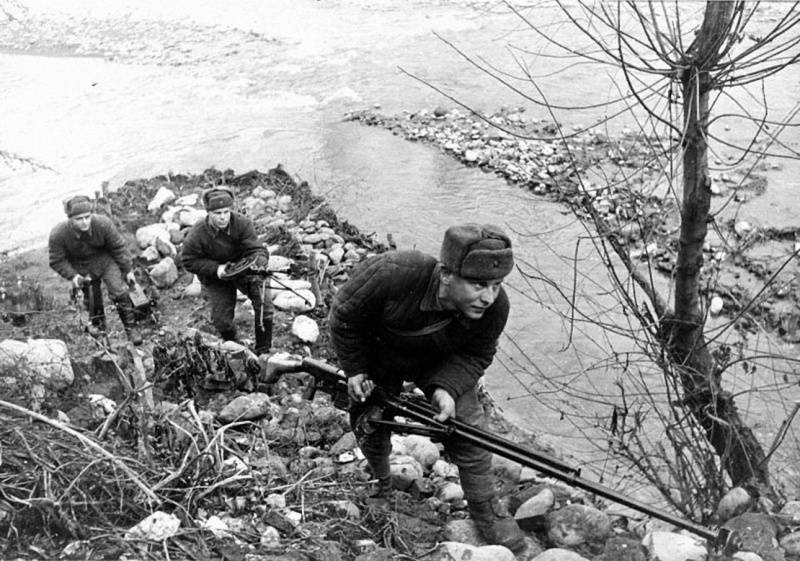
Calculation of the anti-tank rifle PTRS-41 and the machine-gunner on the bank of the Gizeldon river in the North Ossetian village of Gizel
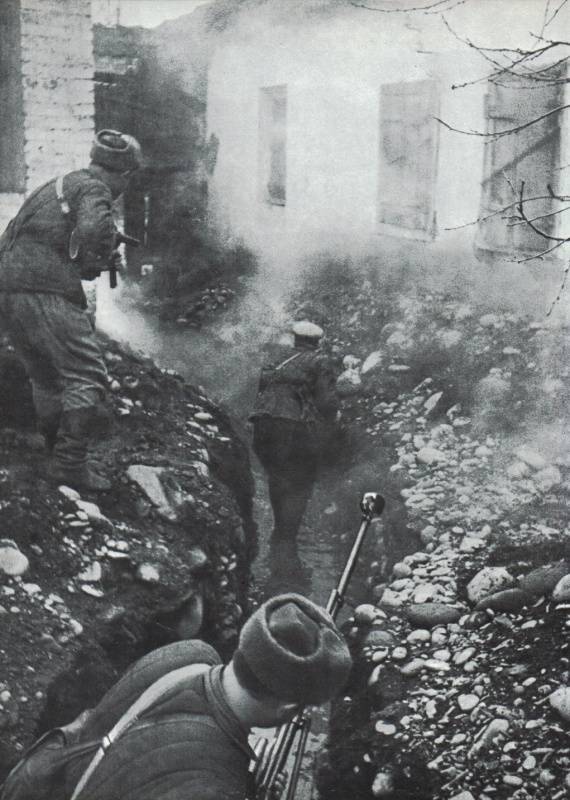
The battle in the village of Gizel, a district of the city of Vladikavkaz (at that time - Ordzhonikidze), where the German offensive in the North Caucasus was stopped. 7 November 1942
Results
In the battle for the Caucasus, the defensive period lasted five months, i.e. more than in the Battle of Stalingrad. During the North Caucasus Strategic Defense Operations (July 25 - 31 December 1942), the troops of the North Caucasus and Transcaucasian Fronts, Black Sea Fleet forces conducted Armaviro-Maikop (August 6-17), Novorossiysk (August 19 - September 26), Mozdok -Malgobek (September 1-28), Tuapse (September 25 - December 20), Nalchik-Ordzhonikidze (October 25 - November 11) defensive operations. As a result, their Wehrmacht was stopped east of Mozdok, on the approaches to Ordzhonikidze, on the passes of the Main Caucasus Range, in the southeastern part of Novorossiysk. Intense battles were fought on the front from 320 to 1000 km and to a depth from 400 to 800 km.
German troops managed to capture the rich agricultural areas of the Don and Kuban, the Taman peninsula, during this time to break through to the foothills of the Main Caucasus Range, to the regions of Ordzhonikidze and Tuapse. The Germans captured a vast territory: the Rostov Region, the Kalmyk Autonomous Soviet Socialist Republic, the Krasnodar and Ordzhonikidze (Stavropol) Territories. The enemy has penetrated into Kabardino-Balkaria, North Ossetia and Chechnya and Ingushetia. These were significant achievements of the Wehrmacht. However, the outcome of the battle for the Caucasus was not decided in favor of Germany. Having sustained the powerful onslaught of the enemy, the Soviet troops decided the main task - they stopped and did not allow the Germans to the oil areas of Grozny and Baku. In brutal defensive battles, they inflicted heavy losses on the enemy, blued his strike force. The Black Sea Fleet ships, its coastal artillery and aviation, and marines provided effective assistance to the ground forces. Ships delivered to the troops of the Black Sea Replenishment Group, military equipment, ammunition, fuel, food. In total, in the second half of 1942 more than 200 thousand people and 250 thousand tons of various cargoes were transported by sea.
As a result, the troops of the North Caucasus and Transcaucasian Fronts, in cooperation with the Black Sea Fleet, the Azov and Caspian military flotillas, foiled the Edelweiss plan. The path of the Nazis in the Caucasus and the Black Sea coast was closed. The enemy, who was counting on destroying the Soviet troops during the rapid campaign against the Caucasus, could not achieve this and, having lost over 100 thousand people, was forced to go on the defensive. The Caucasus, with its "black gold" and other riches, land and sea borders with Turkey remained unconquered. Thus, the main goal of the Wehrmacht campaign in 1942 was not achieved. The battles for the Caucasus and Stalingrad have identified a radical change in the Great Patriotic and World War in general. Strategic initiative in the war passed to the Soviet Union.
Sources:
Beshanov V.V. Year of 1942 - “educational”. Minsk, 2003.
Battle of the Caucasus (1942 — 1943). M. - Vladikavkaz, 2002.
Grechko A. A. Battle for the Caucasus. M., 1967. // http://militera.lib.ru/memo/russian/grechko_aa_1/index.html.
Isaev A.V. When suddenness was gone. History BOB, which we did not know. M., 2006.
History of the Great Patriotic War of the Soviet Union 1941-1945 (in 6 volumes). M., 1960-1965.
Kirin I.D. Black Sea Fleet in the Battle of the Caucasus. M .: Voenizdat, 1958. // http://militera.lib.ru/h/kirin/index.html.
Samsonov A.M. The Stalingrad Battle. M., 1989.
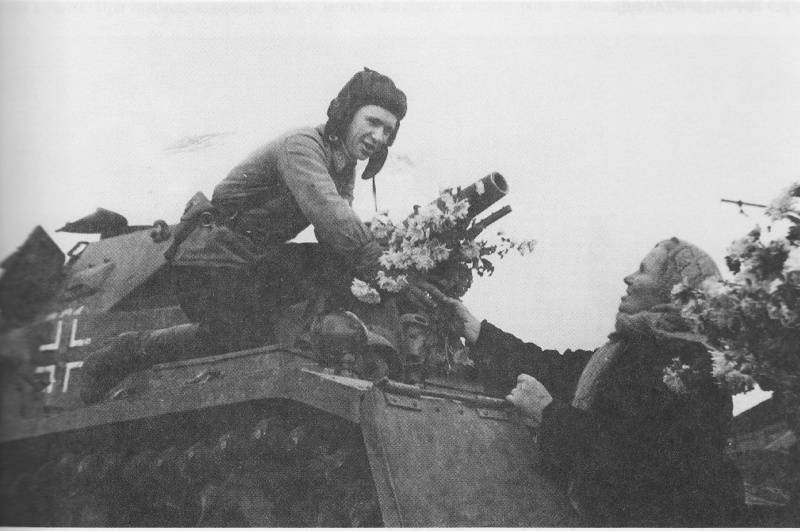
Soviet tanker on a captured German tank Pz.Kpfw IV in Vladikavkaz (at that time Ordzhonikidze). Photo source: http://waralbum.ru/
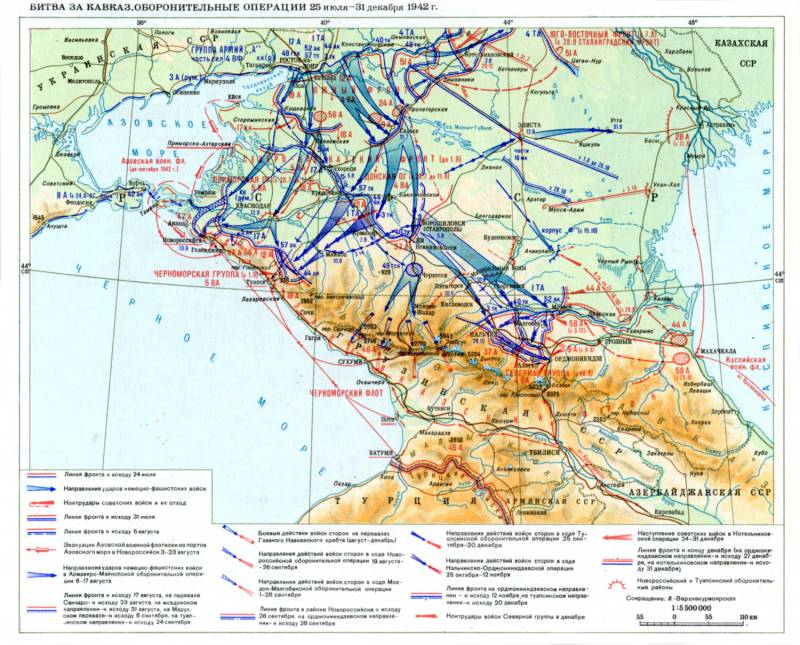
Information